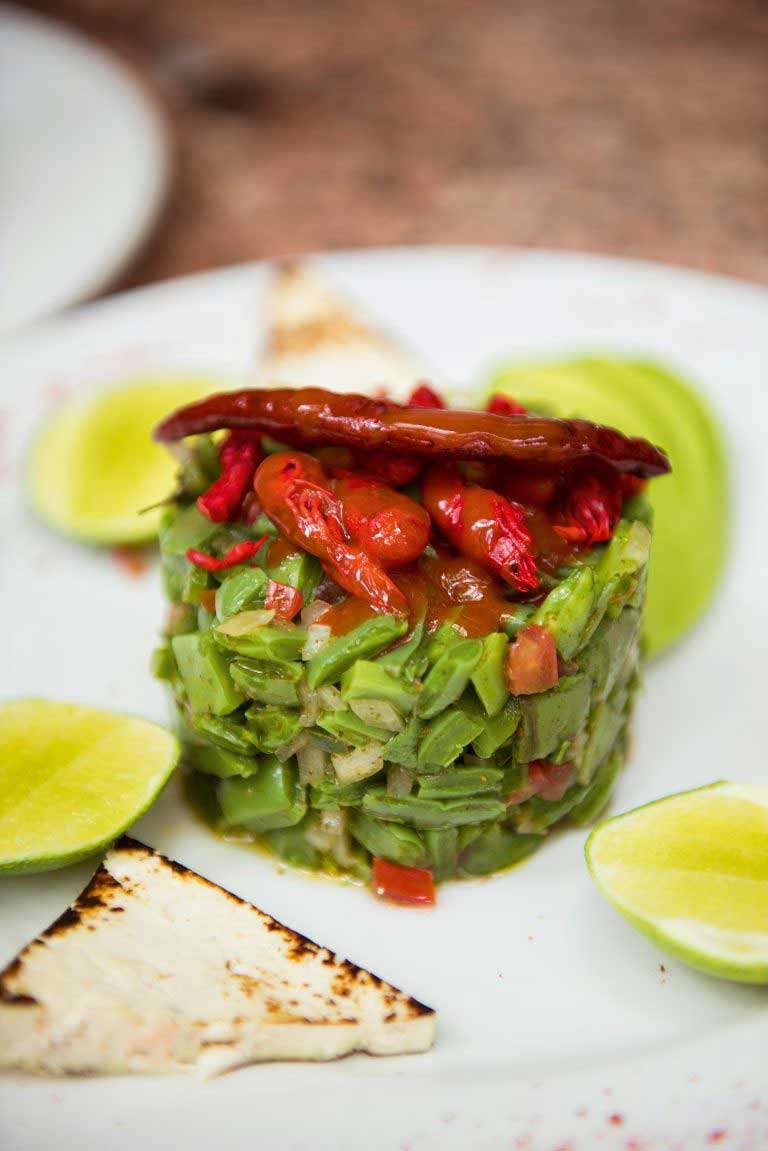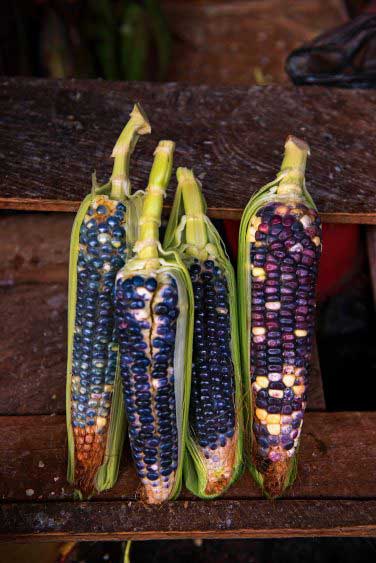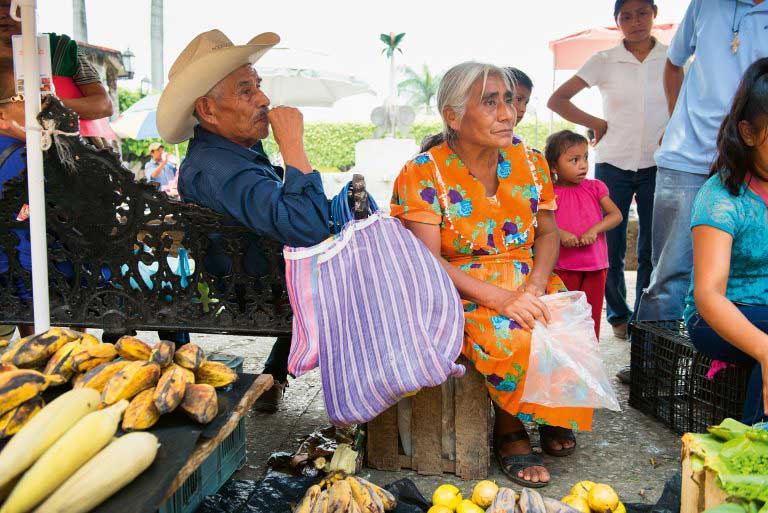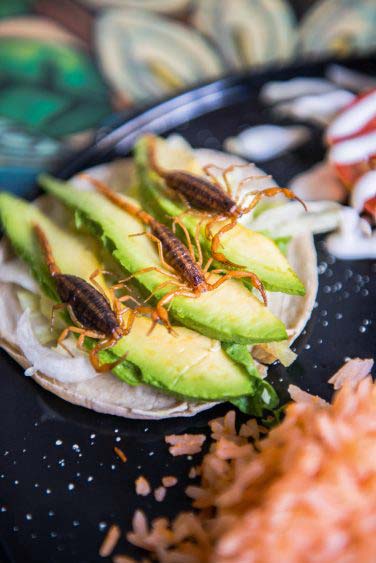Epicurean journeys:
Of Ants & Gods. Mexico’s Exotic Culinary World
by Hossein Amirsadeghi
Mexico is a land of passions and paradoxes, the real deal in the Americas as far as culture, history, nation-building and political drama go, stretching back three thousand years. No other continental American country’s history can match the magical exuberance and cacophony of experiences, the turmoil and periods of violence that Mexicans have endured since the conquistadors arrived to upend millennia of Aztec, Maya, Toltec, Zapotec and Olmec Civilization.
And not just in the New World. Maya astronomy and mathematics were at various stages ahead of European, Near Eastern and Chinese knowledge and expertise. From the mighty stone cities of the Maya to the Aztecs’ military prowess, from its conquest by Spain to its tortuous rise as a modern nation, Mexico can boast a rich history and culture whose origins and roots have been traced back ten millennia. But the passion that Mexicans bring to the table is beyond even their extraordinary history, for the sheer variety and the flavours of Mexican food. In many ways, it’s a misnomer to define the country’s rich culinary heritage under a single banner. Mexico has as many regional and cultural variations in foodstuffs and eating habits as it has in its tribal affinities. Leaving aside the infinite debt that the larger world owes to the vital foodstuffs that have originated in the region of today’s Mexico. Maize, beans, chilli peppers, avocado, cacao (chocolate), vanilla, papaya, guava, tunas (prickly pears) and the mamey fruit all originate from this region.

Chicle (chewing gum) and chaya, squash and sunflower seeds … on and on grows the list on reflection. Without maize (the common corn found in various forms of undress in grocery stores and supermarkets worldwide), the modern world would not have transitioned to its present urban mass culture. As the principal feed for cattle and livestock for the last century the world over, nation states would not be able to satisfy their insatiable, growing appetite for fresh meat as countries advance to the post-in- dustrial urban populations. It’s all about protein intakes, and Mexico’s ancestors had this problem licked even before any cattle, sheep or pigs arrived on their continent alongside the Spanish Conquistadors during the sixteenth century.

Mexican’s ancestors had already developed a taste for creepy-crawlies (ants, bugs, grasshoppers, certain worms and creatures that slither and slide) a long time ago. Don’t screw up your faces at the thought of this before you give your taste buds a chance to savour a lightly fried scorpion laid out on a bed of sliced avocados wrapped in tortilla, with a little chilli sauce on the side, washed down with a shot (or two, or three) of mescal. Consider rattlesnake cooked in pasilla chilli sauce, or escamoles (ant’s eggs); chinicuil (red maguey worms) or grilled iguana. These were not just delicacies at the time of the Aztecs and Mayans, but nutritious beyond value in comparison to their size. In fact, we may squirm at the thought of Entomophagy (the practice of eating insects), like chewing a live Maguey worm, fried ant’s eggs or locusts, but insect farming is the wave of the future. Insects bred in captivity offer a low space-intensive, highly feed efficient, relatively pollution free, high protein source of food for both livestock and humans. Insect farming is becoming increasingly viable as a source of protein in the modern diet as beef and conventional meat forms are very land intensive and produce large quantities of methane. Given this, it may surprise the reader to learn that Mexicans are rather demanding of their food, and they know how to eat well with a discriminating palate. Generic foods are still frowned upon, despite the prevalent onset of North American fast- food chains (with obesity and diabetes a direct consequence). Mexicans know how to tease-out good seasoning – the essential magic of Mexican flavours. The history of the country’s unusual culinary taste is deeply rooted in both ancient and contemporary cultures, and cannot be understood without considering the pre-eminence of maize above all other food components.
‘In maize we were born, in maize we die’
‘In maize we were born, in maize we die’ is a saying which has been handed down through the millennia, for maize enjoyed a powerful mythical reputation among the ancient Mexicans. It was considered to be a sacred plant. From the Olmecs to the Mexica, the plant was associated with many divinities. According to the Maya and other cultures of Mesoamerica, human beings are made out of maize. Moreover, since it is a plant that cannot reproduce on its own, thus requiring the hands of farmers, it is said that we are both the origin and creation of maize. Somehow, we take in a mouthful of ourselves with each bite! The great historian of Nahuatl culture Miguel León Portilla noted that one of the names the Aztecs had for maize was Tonacayo, which means ‘our flesh’, ‘our sustenance’, suggesting a sort of autophagy. To see maize dough take the shape of a perfect disc between the expert hands of a woman, hands that convey it to the comal (griddle) for cooking and from there to the mouth, is a joy that seems to unite all Mexicans. The tortilla is not only bitten into: it wraps, accommodates and stores other food, acting as both napkin and spoon. Once the plate has been wiped clean, even the spoon is eaten.

Not so long ago, the art of tortear (making tortillas by hand) had almost disappeared, especially in urban areas. Nowadays, machines provide most of the tortillas consumed nationally, with a growing global taste for the everyday wrap. The everyday gesture performed by all Mexicans while enjoying maize tortillas, or any of the dishes that unfurl from that same plant source, carry with it a history that stretches back over five thousand years. The ancient inhabitants of Mexico domesticated maize along with many other plants, among them squash, beans, avocados, chilli peppers, tomatoes, and maguey and nopal cacti. The myriad ways of preparing maize, from tortillas of different sizes and colours to tamales that range from small to half a metre in length (sacahuil), not to mention beverages and soups – atoles, champurrados, pozoles – have endured for centuries without interruption. After the Spanish conquest, the ways in which maize was consumed were enriched by the arrival of culinary contributions from other lands. Without maize, there would be no Mexican cuisine as we know it today. Nor, perhaps, would there be any Mexico at all. The traditional milpas system of agriculture (growing maize, beans, squash, chili peppers together in small farmed patches) dating back thousands of years is under challenge from the import of genetically modified maize varieties that are resistant to insects and require less water.

The rising activist clamour for purity, and environmental sustainability has pitted the large agribusiness combines against the traditional smallholdings that still cultivate multiple varieties (and colours) of corn. But it is a losing battle, many varieties of the plant disappearing from local and national markets. Plus, the argument goes, buying imported transgenic corn will eventually lead to local seeds to die out with farmers becoming totally dependent on imports. Leaving aside such contemporary culinary contests, exuberance remains a fundamental trait of Mexican cuisine, a complete life-style that manifests community and enriches its social and cultural life. So much so that in 2010, UNESCO declared traditional Mexican cuisine as an intangible form of cultural heritage. Well-laid Mexican tables decorated with flowers bearing a variety of dishes of every colour imaginable, their textures and enveloping aromas still served on handcrafted objects made especially for the occasion, continues to dazzle the visitor. The sense of endless abundance is there to be appreciated for the enjoyment of the eye, and the pleasures of the palate. Sharing a table in Mexico is a transcendental experience if you’re lucky to be invited: their excess becomes another form of national transcendence. It carries the visitor beyond the dish, palate, or belly to the sense of what Mexican life has in common across all social strata.

















Show Comments +